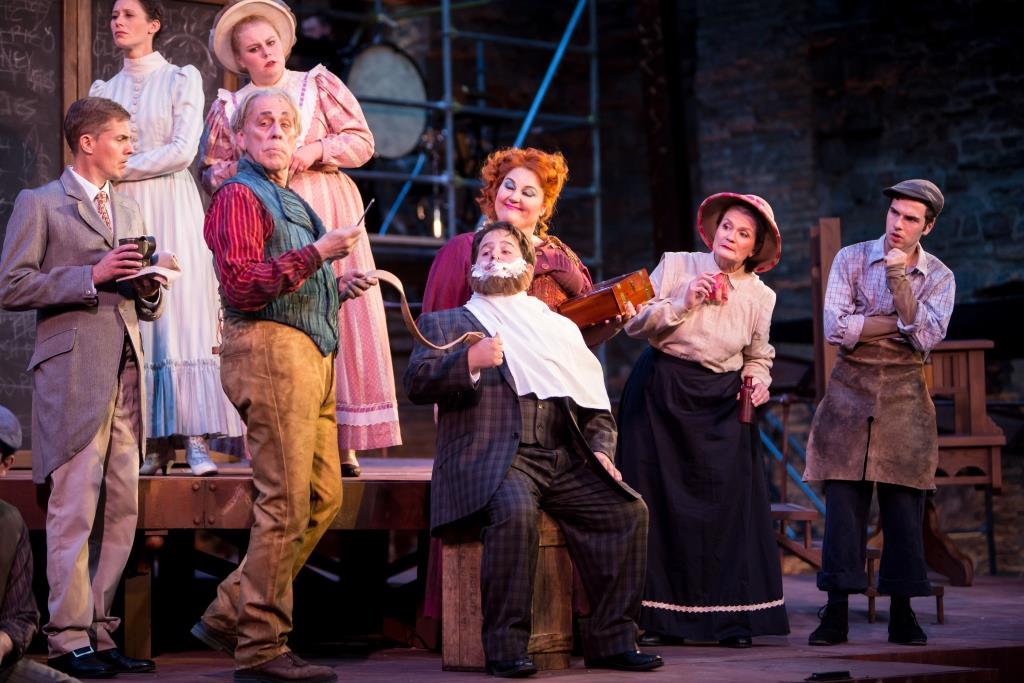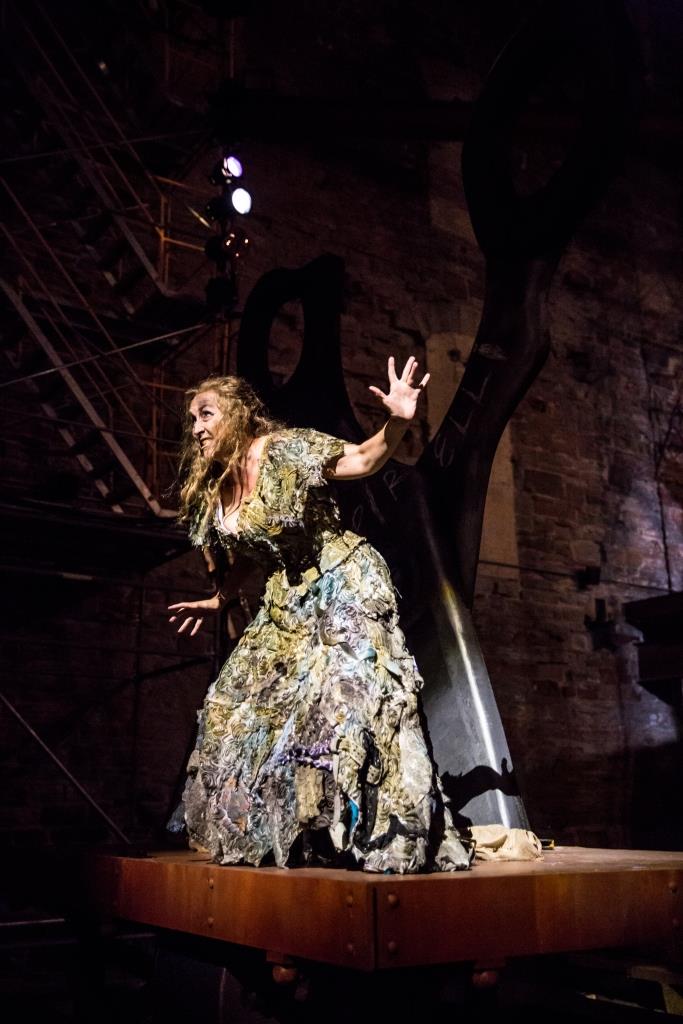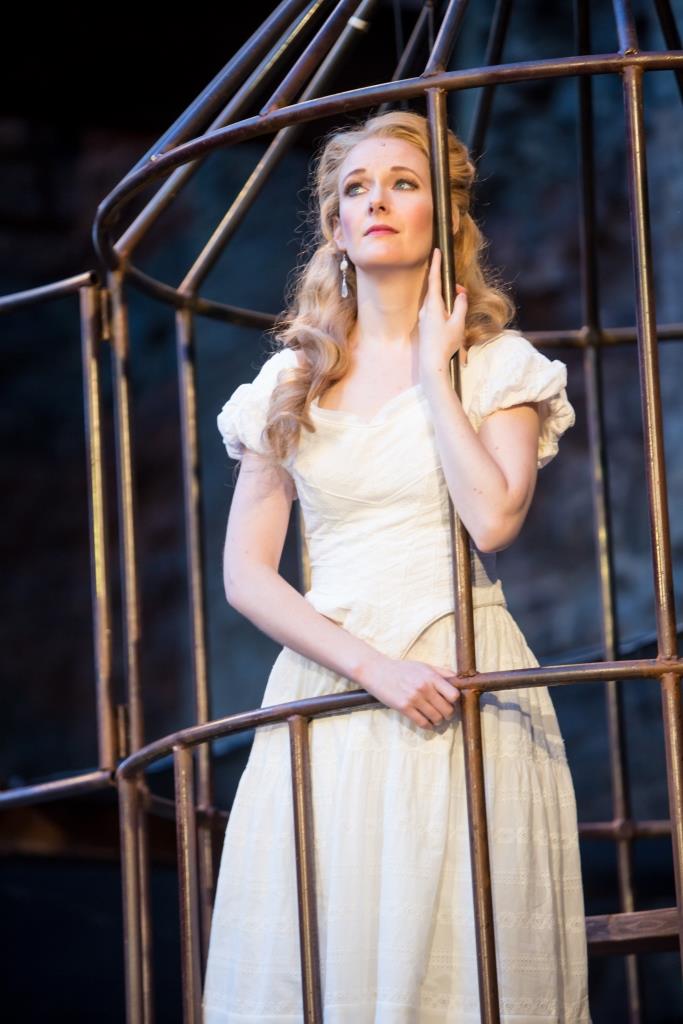Wrath and Ruin (With Singing)
The Mill City Museum's historic Ruin Courtyard makes a surprisingly fitting setting for this rendition of the gleefully gory Sondheim musical, as well as opportunities to reflect on the more sobering vagaries of violence in our own times.

To what do we owe our fascination with the murderous tale of Sweeney Todd? The barber and Victorian-era London serial killer was most vividly brought to life on stage via Stephen Sondheim’s 1979 musical version of British playwright Christopher Bond’s 1973 play, which was based in turn on an 1846 penny dreadful titled The String of Pearls. (Tarnished pearls, to be sure.) The musical includes rape, child abduction, murder, and cannibalism—not to mention deceit, deception, collusion, unlawful imprisonment, exile, and madness ranging from the traumatized to the psychopathic.
The horror, of course, is delivered via a dozen or so lively tunes (Sondheim’s musical includes a libretto by Hugh Wheeler), rife with comedic whimsy, romantic longing or entrepreneurial glee. “YUM…yumyum,” goes the refrain of a tune sung by a chorus of unsuspecting townsfolk ravenously consuming Mrs. Lovett’s meat pies, baked with the flesh of other townsfolk recently dispatched by Mr. Todd, the barber upstairs. In the Mill City Summer Opera’s rendition of Sweeney Todd: The Demon Barber of Fleet Street, directed by David Lefkowich and performed through July 24 in the Mill City Museum’s Ruin Courtyard, the musical is given a vivid interpretation enhanced in no small way by its setting.
Consider that setting. To what do we owe our fascination with ruins? Usually sites of abandonment and decay, of history left to tumble and weather out of sight and out of mind, as structure, mortar and memory bleed back into a wilderness from which they originated, these broken buildings enchant us with a sense of lost possibility. “Nothing beside remains. Round the decay/Of that colossal wreck, boundless and bare,” as Shelley wrote.
The Ruin Courtyard, of course, was brilliantly stabilized and preserved along with the former Washburn A Mill by the Minneapolis architectural firm MSR many years ago. The courtyard—with its pane-less window openings and bricked-over doorways high up on its bare limestone walls; with its rusted smokestacks and beams, the framed remains of milling equipment in the dirt and an open sky above—is itself a work of art.
In his book In Ruins, Christopher Woodward recounts a proposal for re-imagining bombed churches as memorials wherein the authors write that preservation “involves an understanding of the ruin as a ruin, and its re-creation as a work of art in its own right… A ruin is more than a collection of debris. It is a place with its own individuality, charged with its own emotion and atmosphere and drama, of grandeur, of nobility, or of charm. These qualities must be preserved as carefully as the broken stones which are their physical embodiment.”
There may be no better example than the Ruin Courtyard, where grain was ground into the flour that helped transform Minneapolis into the flour-milling capital of the world—at a cost. All of that flour in the air, when lit by a spark off of the machinery, resulted in the mills exploding with some frequency, and workers lost both limbs and lives. In Mill City Summer Opera’s rendition of Sweeney Todd, dismemberment, death, and baking as a murderous industrial enterprise conflate in both musical narrative and setting—via a set within a set, actually, created by New York scenic designer Narelle Sissons, which blends in with the ruin as though it were meant to be.

Initially, Sissons’s massive set—an elevated brick-clad hut surrounded by rusty beams, metal railings, a smokestack like those in the ruin, and a giant wheel—resembles the ship Sweeney Todd (nee Benjamin Barker, and portrayed in the production by the appropriately haggard Robert Orth) arrives on. He’s returned to London a broken man, having been exiled to an Australian penal colony by Judge Turpin (Jake Gardner, just vicious enough), who raped Barker’s wife and absconded with the couple’s baby daughter, now the lovely Joanna (Jeni Houser, luminous in voice and visage) imprisoned in a human-size, gilded birdcage.
For a few weeks the Ruin Courtyard is a scene of entertainment and artistry, where the silly and the serious comingle, at a time when—outside of its confines—real carnage escalates in our own city, as well as throughout the country and world.
Later, Todd discovers the pie baker Mrs. Lovett—who recognizes him as Barker and returns his silver shaving implements. The two establish their nefarious business, the blackboard doors in the hut open to reveal an oven, and the set is recognizable as the pie shop. Todd sets up business in the crow’s nest, the floor above the pie shop, and the rusted wheel turns in concert with the delivery of another victim into the meat grinder. There’s also a giant pair of shears that pop up early on, as Todd and a rival barber stage a shave-off.
During opening night, the first act, at two hours long, dragged a bit; troubles with the sound system resulted in dropped lower notes and garbled words. So, bear with me if I start reading too much into things. But when Joanna, from her cage, sings of the “Green Finch and Linnet Bird,” and a street vendor speaks of blinding caged birds so they sing night and day, and both the Judge and Joanna’s admirer Anthony (Mackenzie Whitney) sing that they “see” Joanna, and the Judge watches his captive ward (whom he also intends to marry) through a telescope, the dovetailing of meaning and message issued a “male gaze” alert in my brain.

Here sight is a means of imprisonment, of control, of blinding a woman to fulfill one man’s desire and demands. (At one point, the Judge “closes” the windows of Joanna’s cage.) To the younger man, sight is an affirmation of Joanna’s existence, but is again fueled by desire and want. (Anthony effectively “falls in love at first sight.”) It is perhaps the most multivalent moment in the show, rendered with musical poignancy and menace.
In the second act, multiple storylines—the Anthony and Joanna romance, the Judge’s pursuit of the escaped Joanna, a scene in a madhouse, and Mr. Todd and Mrs. Lovett’s successful businesses fueled by revenge and murderous greed (respectively)—conflate in fast-paced merriment and mayhem as the sky shifts from twilight to night overhead. Darkness, punctuated by Tom Mays’s dedicated spotlights and ambient illumination, suits the second act. The live orchestra, seated on scaffolding above the set and directed by Brian DeMaris, is perfectly timed to the proceedings below, whether with a scream-like whistle or a giddy melody to underscore the comedic and macabre aspects of the song “A Little Priest.”
For a few weeks, then, the Ruin Courtyard is a scene of entertainment and artistry, where the silly and the serious comingle at a time when—outside of its confines—real carnage escalates in our own city, as well as throughout the country and world. It’s anachronistic, in some sense. Being expected to suspend belief, to leave the past out of the present, particularly when the ruin in which we’re seated is so porous, so open to the vicissitudes of weather, the sounds of jets passing overhead and motorcycles revving down the road, the moths dashing toward the lights—it isn’t possible. And history is alive.
Which is why—despite the giggles from the audience, the piercing cries of a beggar (Emily Pulley), and the giddy choral bedlam of the musical—the overall feeling is a subdued one. What Mill City Summer Opera’s Sweeney Todd conjures is magic, but a magic infused with quiet reflection… and a too ripped-from-the-headlines set of dramatic storylines. It’s a bloody good production. Unfortunately, we also live in a culture undergoing seismic shifts in bloody, uncertain and horror-filled times.
Related performance information: Mill City Summer Opera’s rendition of Sweeney Todd will take place in the Mill City Museum Ruin Courtyard in Minneapolis July 15 through July 24, 2016. For tickets and specific performance times, visit the website: http://www.millcitysummeropera.org/.